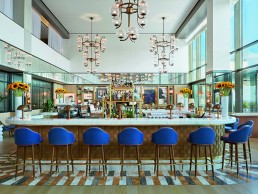
Four Seasons Astir Palace, Athens
With the help of Martin Brudnizki Design Studio and Lighting Design International, the Four Seasons Astir Palace undergoes a complete interiors overhaul as the legendary hotel moves into a new chapter.
On the sophisticated Athens Riviera, at the tip of a pine-clad peninsula, Four Seasons offers the best of both worlds with the Astir Palace: a laid-back seaside escape just 30 minutes from the historical city centre. A pine-clad sanctuary of 75 acres, it features three private beaches, eight exciting restaurants, lounges and bars, upscale retail, and a spa inspired by the teachings of Hippocrates.
Having recently undergone a complete overhaul of what has been a legendary hotel complex for many decades, it is now entering a new chapter and Lighting Design International (LDI) was commissioned to design the lighting scheme for the two renovated hotels: Arion and Nafiska. While the structural elements were retained, the building was completely renovated and LDI worked closely with the project management and design team in order to create a high-end lighting scheme for both hotels.
Understanding and achieving lighting design with the Four Seasons’ ethos of ‘a home far away from home’ in mind was key for the success of the project. Having worked with Four Seasons on numerous occasions, LDI thoroughly understood the brand’s vision – with the brief this time to design a sophisticated lighting scheme with a residential feel.
One of the main challenges with this project – as is so often the case – was getting the local contractor and project team to understand the value of lighting design and how it is achieved. Fortunately, as with all hotel projects, a mockup room was built and once realised, the contractor and project team fully understood the value of LDI’s design and value of the specified products.
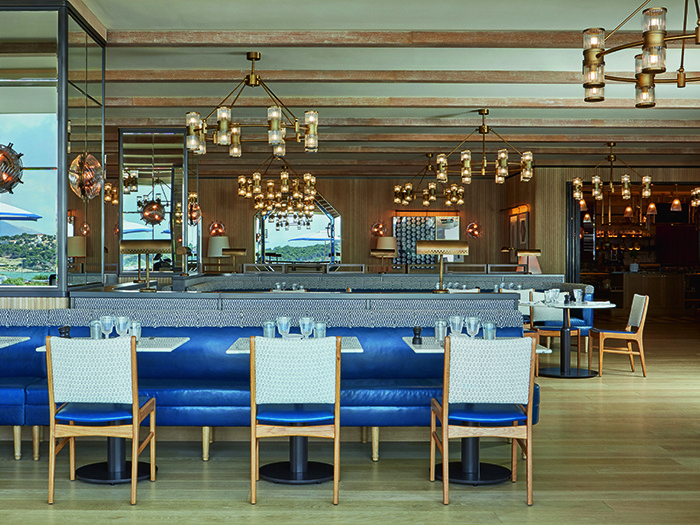
“One of the strengths of this project is that once the lighting brief was defined, it was thoroughly maintained,” Sandra Brookes, Senior Designer at LDI, tells darc. “The final design was an elegant sophisticated ambience with a residential feel, which represented the initial vision agreed with the client.
“The original layout was maintained throughout, but the building services and interiors were totally upgraded. Therefore, we had the opportunity to have a new and more current lighting scheme and control system incorporated within the building, leaving a minimal lighting aesthetic visible. This leaves the guest to enjoy the warm and inviting lighting ambience without knowing where the equipment is located. Bespoke tailored details were developed in conjunction with the interior designers Martin Brudnizki Design Studio and Meyer Davis and incorporated within furniture and the building envelope.”
For Brookes, what makes this project special is that the two hotels were unique with a distinct lighting ambience that defines them. Arion’s look is more sophisticated and aimed at couples and singles, while Nafiska is more relaxed and family orientated, with the lighting working to enhance each hotel’s distinct personality.
Arion’s interior is soft and fresh, and the lighting embraces a distinctly sophisticated atmosphere. The palette of finishes uses sandy hues, while the lighting adopts a minimal approach with all elements integrated within both the joinery and architectural details of the building’s envelope; on arrival, guests are welcomed by the minimal aesthetic of the reception area.
“This space deliberately uses dimmed lighting levels to set a calm and welcoming atmosphere,” says Brookes. “Contrastingly, the lounge lobby, found directly beyond this area boasts a double height, voluminous space with floor-to-ceiling glazing that offers astonishing sea views.”
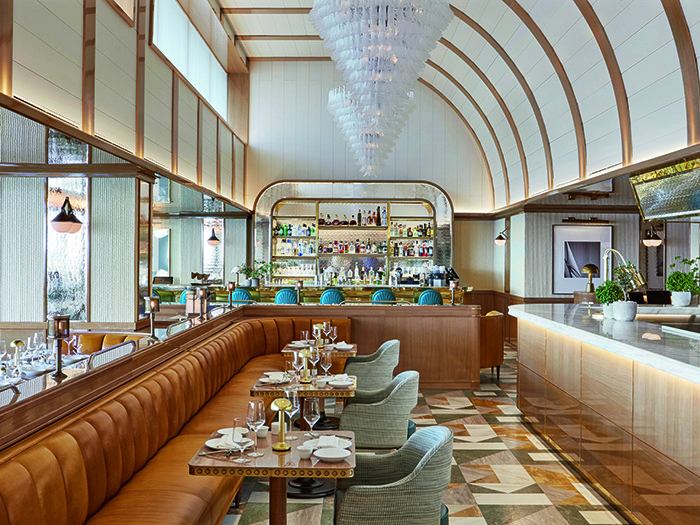
The unique and different approach taken to lighting Nafiska’s interior lighting is dramatic and modern, with bold decorative gestures highlighting its livelier atmosphere. Unlike many traditional hotels, Nafiska’s lobby is on the top floor, providing unrivalled views over the Mediterranean. On arrival, guests are welcomed by a lit water feature and an Antony Gormley sculpture with a backdrop that resembles a forest of illuminated pillars.
Guests are encouraged to descend from the top floor to the swimming pool area below, following a journey through spaces that are interlaced with each other via a cohesive yet distinctive lighting atmosphere.
“Throughout both hotels there is a true balance between the architectural and decorative lighting,” continues Brookes. “Good examples of this are within the restaurants at both hotels (worked on alongside Martin Brudnizki Design Studio). The jewel-like pendants in the Avra lounge take centre stage as you enter the reception area, creating a visual impact, while oversized bespoke decorative luminaires with integral spotlights help to retain a clean soffit and introduce drama.
“The space presents floor to ceiling windows and seamless lighting integration with indoor-outdoor spaces was key; the warm and welcoming atmosphere is provided mainly through decorative fittings and soft lighting integrated within the furniture and building fabric.”
With the two restaurants located in very distinctive buildings, the Martin Brudnizki Design Studio (MBDS) team was mindful of ensuring they retained distinctive looks yet still worked in harmony with each other and the rest of the hotel. They found that sharing a design language between the two spaces helped to ensure the restaurants felt connected, but through introducing different colour palettes and finishes, were able to create two distinct and unique restaurants, all of which would cater to guests.
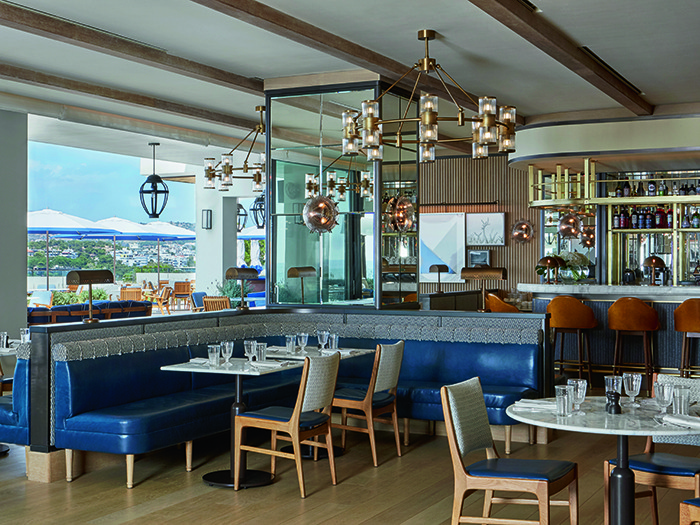
As with LDI, MBDS has worked with Four Seasons for a number of years on projects from the US, to Dubai, to Canada and so it was a natural fit for them to also work on the new-look Astir Palace.
Both restaurants have very high ceilings, meaning MBDS could have a lot of fun with the decorative lighting elements. In the Pelagos restaurant the ceiling is panelled in timber, miming the shape of a boat’s hull. From the ceiling, the design team commissioned oversized chandeliers crafted from Murano glass, creating a bold and glamorous result.
Over the Avra lounge and adjoining Mercato restaurant, the team designed a more contemporary, abstract light fitting crafted from brass. There were three in total, hanging above the central bar – the light reflecting perfectly in the surrounding antique mirror detailing, which helped ensure the ambience was bright and welcoming.
Using a mixture of bespoke and off-the-shelf decorative lighting pieces from manufacturers including And Object, Charles Edwards, Collier Webb and Porta Romana to name just a few, a mixture of low-level lighting and main, overhead lighting was used throughout the two restaurants to ensure the ambience created was ‘just right’.
Since Avra and Mercato offer hospitality from breakfast through to dinner, MBDS needed to make sure the lighting would work for all situations. Smaller, table lamps provide the perfect way to introduce a different ambience for evening situations; this was also the case for Pelagos, which is only used from lunch through to dinner. In Pelagos, MBDS utilised large glass chandeliers, which helps elevate the restaurant, ensuring the distinction between Mercato and Pelagos was retained.
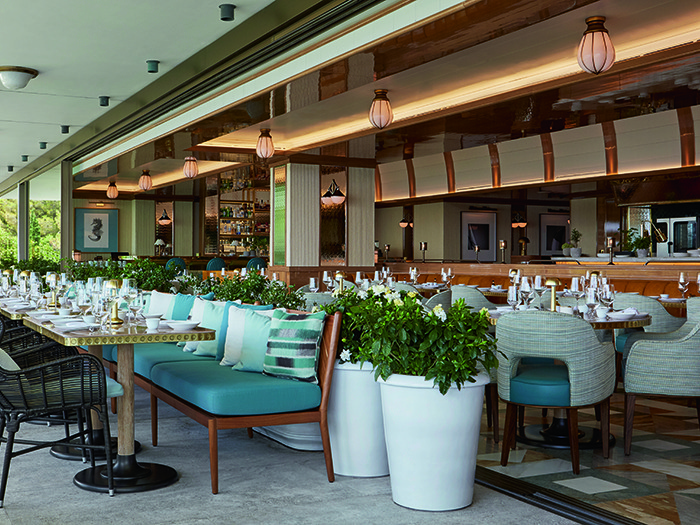
For both hotel interiors at Four Seasons Astir, low-glare and concealed architectural lighting discreetly illuminates the spaces throughout, while decorative fixtures provide warmth at a more domestic scale. The luminaires specified use either warm or tuneable white (2200K – 2700K) LED sources, while the decorative fixtures are specified with 2200K lamps. A Lutron lighting control system has been used to allow the lit canvas of the restaurants to be adjusted using scene setting capabilities.
Reflecting on the projects, MBDS tells darc: “We are really pleased with how we ensured the two spaces had distinctive identities yet worked in harmony with one another. This was achieved through a shared use of similar materiality and colour palette; the result is two restaurant concepts that hang together in harmony yet retain distinct identity.
“This was our first project in Greece, so it was exciting to make our mark in a new territory. As with all projects, we researched the area to seek inspiration. As Greece has such a rich history, we found there was plenty to draw from to help create a rich and interesting narrative for the two new restaurants.”



